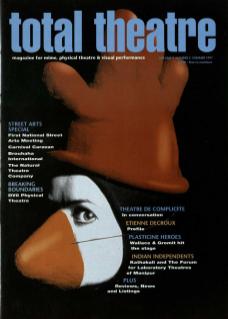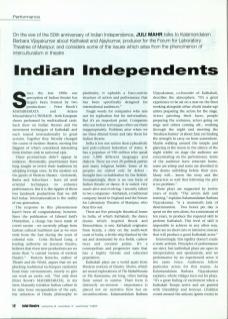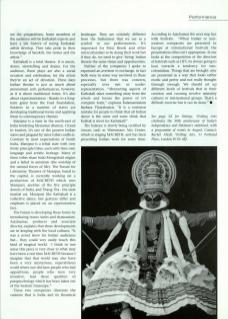Since the late 1980s our perception of Indian theatre has largely been formed by two productions – Peter Brook's Mahabharata and Ariane Mnouchkine's L’Indiade – both European shows performed by multicultural casts. Each drew on Indian themes and the movement techniques of Kathakali and each toured internationally to great acclaim. Together they literally changed the course of modern theatre, moving the flagpost of what's considered interesting from kitchen sink to universal epic.
These productions didn't appear in isolation. Historically, practitioners have long sought to revive their traditions by adopting foreign ones. In the modern era the giants of Western theatre – Grotowski, Barba and Schechner – have all used oriental techniques to enhance performances. But it is the ripples of those two landmark productions that we still feel today. Internationalism is the reality of our generation.
The response to this phenomenon hasn't been all congratulatory, however. Since the publication of Edward Said's Orientalism, a charge has been made of covert racism – we currently pillage from Eastern cultural traditions just as we once stole from the East during the years of colonial rule. The critic Richard Long, a leading authority on Javenese theatre, believes that these new productions are no more than ‘a curried version of western theatre’. Rustom Barucha, author of Theatre and the World, argues that we are plucking traditional techniques randomly from their environments, merely to give our work an exotic veil. ‘Not only does [Peter Brook's Mahabharata], in my view, blatantly trivialize Indian culture in its nine hour encapsulation of the epic, the reduction of Hindu philosophy to platitudes, it upholds a Euro-centric structure of action and performance that has been specifically designed for international audiences.’
Tough words for companies who aim not for replication but for universalism. But it's an important point. Companies who use Indian techniques often use them inappropriately. Problems arise when we see these diluted forms and take them for Indian theatre.
India is less one nation than a pluralistic and poly-cultural federation of states. It has a populace of 950 million who speak over 1000 different languages and dialects. There are over twenty political parties and many religious beliefs. Some of its peoples are united only by defeat – brought into co-habitation by the British. Unsurprisingly, there is no one form of Indian theatre or dance. It is varied, very much alive and evolving. I recently talked to two companies – Kathakali, a traditional company based in England and the Forum for Laboratory Theatres of Manipur, who bear this out.
There are five principle theatrical forms in India, of which Kathakali, the dance drama which inspired Brook and Mnouchkine, is one. Kathakali originates from Kerala, a state on the south-west coast of India, a fertile strip flanked by the sea and dominated by rice fields, cashew trees and coconut palms. It's a cosmopolitan and progressive state that has a highly literate and educated population.
Kathakali plays are a world apart from Western notions of theatre. Shows, which are moral explorations of The Mahabharata or The Ramayana, are long, often lasting from sunset to sunrise. Their form is distinctly un-western – importance is placed not on narrative flow but on circumlocutions. Kalamandalam Barbara Vijayakumar, co-founder of Kathakali, describes the atmosphere. ‘It's a great experience to be sat on a mat on the floor working alongside other chutti (make-up) artists preparing the actors for the stage. Actors painting their faces, people preparing the costumes, actors going on stage and others coming off... working through the night and meeting the 'tiredness barrier' at about 2am yet finding the strength to carry on from somewhere. Maybe walking around the temple and glancing at the moon in the silence of the night whilst on stage the audience are concentrating on the performance. Some of the audience have returned home, some are asleep and some are absorbed in the drama unfolding before their eyes. Many will... know the story and the characters so well that following the plot is no problem.’
These plays are supported by twelve years of study. ‘The actors’ skill and training,’ explains Kalamandalam Barbara Vijayakumar, ‘is a mammoth task of determination. Two hours per day is spent on the eyes alone, for a minimum of ten years, to produce the required skill to perform Kathakali. This level of skill is impossible to achieve in any other way, there are no short cuts or intensive courses that will produce a good Kathakali actor.’
Interestingly, this rigidity doesn't create a static artform. Principles of performance are strict, but individual plays are open to interpretation and spontaneity, and no performance by an experienced actor is the same twice. Audiences follow particular actors for this reason. As Kalamandalam Barbara Vijayakumar explains, whole villages turn out for plays. ‘It's a great feeling of excitement when a Kathakali Troupe arrive and are greeted with friendship and honour. Children crowd around the aniyara (green room) to see the preparations. Some members of the audience will be Kathakali experts and have a life history of seeing Kathakali artists develop. They take pride in their knowledge of Sanskrit, the stories and the artists.’
Kathakali is a total theatre. It is music, dance, storytelling and drama. For the audience, these plays are also a social occasion and celebration; for the actors they're an act of devotion. These days Indian theatre is just as much about proscenium arch performances, however, as it is about traditional forms. It's also about experimentation – thanks to a long-term grant from the Ford Foundation, theatres in a number of states are developing traditional forms and applying them to contemporary themes.
Manipur is a state in the north-east of India bordering Myanmar (Burma). Closed to tourists, it's one of the poorest Indian states and plagued by inter-tribal conflicts. Contrary to most expectations of North India, Manipur is a tribal state with over thirty principle tribes, each with their own language and artistic heritage. Many of these tribes share Indo-Mongoloid origins and a belief in animism (the worship of the natural forces of life). The Forum for Laboratory Theatres of Manipur, based in the capital, is currently working on a production of Macbeth which uses Manipuri, another of the five principle dances of India, and Thang Tha – the state martial art. Manipuri like Kathakali is a collective dance, but gestures differ and emphasis is placed on an expressionless face.
The Forum is developing these forms by introducing trance states and shamanism. Ajaykumar, producer and associate director, explains that these developments are in keeping with the local cultures. ‘It was a novel show for Indian audiences but... they could very easily touch this kind of magical world. I think in one sense this piece is very close to what may have been a real time Macbeth because I imagine that that world may also have been a very mysterious, superstitious world where one did have people who had apparitions, people who were very intuitive, had these qualities of parapsychology which has been taken out of the western timescape.’
These two companies illustrate the vastness that is India and its theatrical landscape. They are certainly different from the Indianness that we use as a symbol in our performances. It's important for Peter Brook and other interculturalists to be doing their work but if they do, we need to give 'living' Indian theatre the same status and opportunities.
Neither of the companies I spoke to expressed an aversion to exchange, in fact both were in some way involved in these processes, but there was concern, especially over mis- or under-representation. ‘Abstracting aspects of Kathakali takes something away from the whole and loses the power of its complete form,’ explains Kalamandalam Barbara Vijayakumar. ‘It is a common mistake for people to think that all Indian dance is the same and some think that Kathak is short for Kathakali!’
The balance is slowly being rectified by venues such as Watermans Arts Centre, which is staging Macbeth, and has been presenting Indian work for some time.
According to Ajaykumar the next step lies with festivals. ‘When Indian or non-western companies are presented in Europe at international festivals the presentation often isn't appropriate. If one looks at the composition of the directors of festivals such as LIFT, it’s always going to lean towards a tendency for neocolonialism. Things that are brought over are presented in a way that looks rather exotic and pretty and not really thought through enough. We should set up different kinds of festivals that in their creation and running involve minority cultures or international groups. That's a difficult exercise but it can be done.’
Visiting Arts celebrates the 50th anniversary of India's independence and Pakistan's statehood, with a programme of events in August.


